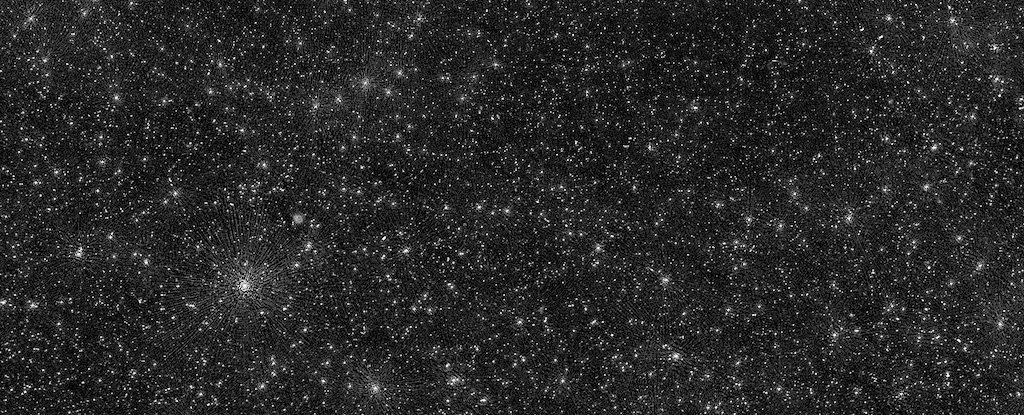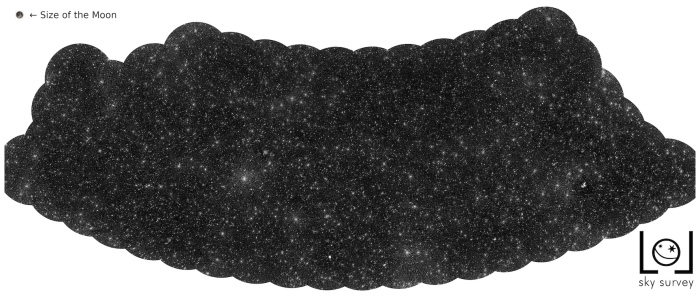
Posted on 01/03/2022 5:56:49 AM PST by Red Badger

(LOFAR/LOL Survey)
The image above may look like a fairly normal picture of the night sky, but what you're looking at is a lot more special than just glittering stars. Each of those white dots is an active supermassive black hole.
And each of those black holes is devouring material at the heart of a galaxy millions of light-years away – that's how they could be pinpointed at all.
Totaling 25,000 such dots, astronomers created the most detailed map to date of black holes at low radio frequencies in early 2021, an achievement that took years and a Europe-sized radio telescope to compile.
"This is the result of many years of work on incredibly difficult data," explained astronomer Francesco de Gasperin of the University of Hamburg in Germany. "We had to invent new methods to convert the radio signals into images of the sky."

(LOFAR/LOL Survey)
When they're just hanging out not doing much, black holes don't give off any detectable radiation, making them much harder to find. When a black hole is actively accreting material – spooling it in from a disc of dust and gas that circles it much as water circles a drain – the intense forces involved generate radiation across multiple wavelengths that we can detect across the vastness of space.
What makes the above image so special is that it covers the ultra-low radio wavelengths, as detected by the LOw Frequency ARray (LOFAR) in Europe. This interferometric network consists of around 20,000 radio antennas, distributed throughout 52 locations across Europe.
Currently, LOFAR is the only radio telescope network capable of deep, high-resolution imaging at frequencies below 100 megahertz, offering a view of the sky like no other. This data release, covering four percent of the Northern sky, was the first for the network's ambitious plan to image the entire Northern sky in ultra-low-frequencies, the LOFAR LBA Sky Survey (LoLSS).
Because it's based on Earth, LOFAR does have a significant hurdle to overcome that doesn't afflict space-based telescopes: the ionosphere. This is particularly problematic for ultra-low-frequency radio waves, which can be reflected back into space. At frequencies below 5 megahertz, the ionosphere is opaque for this reason.
The frequencies that do penetrate the ionosphere can vary according to atmospheric conditions. To overcome this problem, the team used supercomputers running algorithms to correct for ionospheric interference every four seconds. Over the 256 hours that LOFAR stared at the sky, that's a lot of corrections.
This is what has given us such a clear view of the ultra-low-frequency sky.
"After many years of software development, it is so wonderful to see that this has now really worked out," said astronomer Huub Röttgering of Leiden Observatory in the Netherlands.
Having to correct for the ionosphere has another benefit, too: It will allow astronomers to use LoLSS data to study the ionosphere itself. Ionospheric traveling waves, scintillations, and the relationship of the ionosphere with solar cycles could be characterized in much greater detail with the LoLSS. This will allow scientists to better constrain ionospheric models.
And the survey will provide new data on all sorts of astronomical objects and phenomena, as well as possibly undiscovered or unexplored objects in the region below 50 megahertz.
"The final release of the survey will facilitate advances across a range of astronomical research areas," the researchers wrote in their paper.
"[This] will allow for the study of more than 1 million low-frequency radio spectra, providing unique insights on physical models for galaxies, active nuclei, galaxy clusters, and other fields of research. This experiment represents a unique attempt to explore the ultra-low frequency sky at a high angular resolution and depth."
The results have been published in Astronomy & Astrophysics.
A version of this article was first published in February 2021.
I have long wondered - how could we tell the difference between the Universe expanding versus contracting into a massive universal black hole with its event horizon being the Big Bang?
Objects further “down” the black hole from us would seem to be receding from us because they are travelling faster than us.
Objects not as far “down” the black hole seem to be receding from us because we are travelling faster than they.
I thought the two seasons were Summer and Hockey..............
Excellent!...................

Like so many others...
White lights self identifying as black holes.
Lol… ‘Oh the problem… it’s back…”
It’s been a while since I’ve seen that movie. I forgot the lines that went with that scene. LOL
What if I dont believe you?
Another mind-boggling image (s) are by the Hubble. Do a DDGo search of “hubble Legacy Field”. There are a family of images that are downloadable of galaxies imaged by the Hubble. These are from a spot in the sky the size of a nickle held at arm’s length. There are hundreds of thousands.
The only free imaging software I’ve found that can handle the file size is Gimp. Nothing M$ will touch them. Load the software, load the image, and keep increasing the focus — those little pinwheels and globs are millions of stars.
With a really good telescope in your backyard on a clear night you can see only a couple of galaxies.
“I dare say…”
Reminds me of the ceiling of the old Tampa Theater on Franklin Street. Sort of like taking a sheet of black construction paper, punching a bunch of small holes in it, and then holding it up to a light source.
In Florida we have two seasons:
“Lots of Tourists” and “Somewhat Less Tourists”.............
Didn’t Don Lemon of CNN speak about black holes?
Or was that black hos?
5.56mm
He knows a lot about Black Holes, up close and personal................
I’m still laughing as I write this. Thank you.
That sucks.
That’s cool.
Disclaimer: Opinions posted on Free Republic are those of the individual posters and do not necessarily represent the opinion of Free Republic or its management. All materials posted herein are protected by copyright law and the exemption for fair use of copyrighted works.